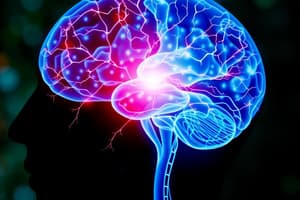Podcast
Questions and Answers
What is the primary focus of Physiological Psychology?
What is the primary focus of Physiological Psychology?
- Study of machines
- Study of the brain and behavior (correct)
- Study of only behavior
- Study of genes
What is the definition of Behavior?
What is the definition of Behavior?
A person's actions.
What does Neuroscience study?
What does Neuroscience study?
- Cells in isolation
- The nervous system at all levels (correct)
- Only human behavior
- Only the brain
The mind and body are described as __________ in the context of the Mind-Brain Problem.
The mind and body are described as __________ in the context of the Mind-Brain Problem.
What are the two philosophical views regarding the relationship between the mind and brain?
What are the two philosophical views regarding the relationship between the mind and brain?
Who emphasized the physical explanation of behavior?
Who emphasized the physical explanation of behavior?
What is Descartes' Hydraulic Model?
What is Descartes' Hydraulic Model?
What is the difference in electrical charge called?
What is the difference in electrical charge called?
The resting potential of a neuron is approximately __________.
The resting potential of a neuron is approximately __________.
Hypertrophy is a decrease in polarization.
Hypertrophy is a decrease in polarization.
What does Action Potential allow a neuron to do?
What does Action Potential allow a neuron to do?
What is the role of Glial Cells?
What is the role of Glial Cells?
______ is when a neuron fires without environmental stimulation.
______ is when a neuron fires without environmental stimulation.
What does curare block?
What does curare block?
What is the Central Nervous System (CNS) composed of?
What is the Central Nervous System (CNS) composed of?
What does the term 'tract' refer to?
What does the term 'tract' refer to?
What is the Peripheral Nervous System (PNS) composed of?
What is the Peripheral Nervous System (PNS) composed of?
What is a nerve?
What is a nerve?
Which structures are part of the forebrain?
Which structures are part of the forebrain?
What is the outer surface of the cerebral hemispheres called?
What is the outer surface of the cerebral hemispheres called?
What is a gyrus?
What is a gyrus?
What is a sulcus?
What is a sulcus?
What are fissures?
What are fissures?
What is gray matter primarily made up of?
What is gray matter primarily made up of?
What is white matter?
What is white matter?
What is acetylcholine?
What is acetylcholine?
Flashcards are hidden until you start studying
Study Notes
Physiological Psychology Overview
- Studies the relationship between brain and behavior.
- Explores how physical processes in the brain influence actions.
Neuroscience and Its Aspects
- Neuroscience is a multidisciplinary field focused on the nervous system.
- Key aspects include neurology, genetics, chemistry, psychobiology, and contributions from computer science and theoretical physics.
Mind-Brain Problem
- Distinguishes between the nonphysical mind and the physical brain.
- Philosophically supports dualism—mind and brain as separate entities.
Philosophical Views
- Dualism: Mind and brain exist in different realms, with the mind controlling the brain.
- Monism: Mind and brain are one, indicating that mental processes are a result of physical brain functions.
René Descartes Contributions
- Emphasized physical explanations of behavior in the 17th century.
- Proposed that the pineal gland is the "seat of the soul" where the mind interacts with the body.
- Introduced a hydraulic model explaining the nervous system as a plumbing system.
Key Terminology in Genetics
- Gene: Unit of heredity found on chromosomes.
- Chromosomes: Humans possess 46 arranged in 23 pairs.
- DNA: Carries genetic information, structured as a double strand.
Genetic Attributes
- Dominant Genes: Express effects regardless of the pair.
- Recessive Genes: Express effects only when paired with the same recessive gene.
- Heterozygous: Different genes (Rr).
- Homozygous: Identical genes (RR or rr).
- Genotype: Genetic trait; Phenotype: Expressed physical trait.
Neuron Structure and Function
- Neurons are specialized cells transmitting information throughout the body.
- Composed of dendrites, cell body, and axon.
- Approximately 100 billion neurons are present in the human brain.
Types of Neurons
- Motor Neurons: Transmit signals from the brain to muscles.
- Sensory Neurons: Carry sensory information to the brain.
- Interneurons: Connect neurons within the CNS.
Neural Communication
- Synapse: Connection where communication between neurons occurs.
- Presynaptic Neuron: Sends signals, while the Postsynaptic Neuron receives them.
- Chemical signals, including neurotransmitters, are released across synaptic clefts.
Action Potentials and Neural Activity
- Action Potential: Brief reversal of membrane polarization that allows neurons to transmit information quickly.
- Differences in neuron firing rates indicate the strength of stimuli—stronger stimuli lead to faster firing.
Neurotransmitter Modulation
- Excitatory Postsynaptic Potential (EPSP): Increases likelihood of an action potential; results in partial depolarization.
- Inhibitory Postsynaptic Potential (IPSP): Decreases likelihood of an action potential; leads to hyper-polarization.
Synaptic Modulation Mechanisms
- Presynaptic Excitation: Increases neurotransmitter release.
- Presynaptic Inhibition: Decreases neurotransmitter release.
- Auto-receptors regulate neurotransmitter levels in the synaptic cleft.
Brain Structuring
- Central Nervous System (CNS): Contains the brain and spinal cord.
- Peripheral Nervous System (PNS): Comprises cranial and spinal nerves.
- Forebrain: Houses important structures like the cerebral hemispheres, corpus callosum, thalamus, and hypothalamus.
Cerebral Cortex Features
- The outer layer of the brain is characterized by gyri (ridges) and sulci (grooves), with deep sulci called fissures.
- Gray Matter: Consists primarily of unmyelinated cell bodies.
- White Matter: Features myelinated axon pathways within the brain.
Neurotransmitters
- Acetylcholine: Significantly involved in muscle activation and cognitive functions such as learning.
Studying That Suits You
Use AI to generate personalized quizzes and flashcards to suit your learning preferences.




